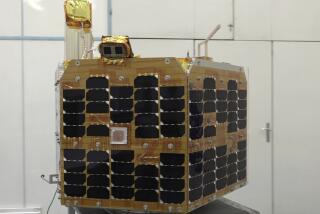North Korea’s rocket launch: the fallout
- Share via
WASHINGTON — Although a crucial third stage of a North Korean rocket apparently failed in a launch Sunday, U.S. military and intelligence officials and weapons experts said the test raises new concerns about advances in Pyongyang’s mastery of missile technology.
North Korea said the purpose of the launch was to place a civilian satellite into orbit. U.S. and Western officials said it was not clear whether there was a satellite on the rocket, but that if there was, it never made it into orbit.
The launch was the latest North Korean rocket test to fall short of objectives, but still shows disturbing progress in that country’s pursuit of the ability to deliver a nuclear warhead, according to U.S. officials and weapons experts. They said the mission could boost the regime’s ambitions and its standing among countries with similar goals.
Unlike North Korea’s 2006 test in which a Taepodong 2 rocket failed 40 seconds after launch, the rocket this time successfully went through the first two stages.
A senior Defense official said the military was now “clearly more worried” about the North’s missile technology. The senior official spoke on the condition of anonymity because the Pentagon did not authorize anyone to speak publicly about the launch.
U.S. officials said the rocket launched Sunday was a multistage Taepodong 2 and there was broad agreement that the North Korean explanation about launching a satellite was merely cover for a long-range ballistic missile test.
“The U.S. knows enough to conclude this was not a peaceful satellite launch,” said Michael J. Green, a senior advisor at the Center for Strategic and International Studies.
Weapons experts said that while the launch cleared Japan, it is unclear whether the rocket ever reached its third stage, or failed after its second engine fired, sending its remaining booster as well as its payload into the Pacific Ocean.
“There was no successful satellite launch,” said a U.S. official familiar with intelligence reports on the rocket and discussing it on condition of anonymity. “If indeed there was a satellite involved, that didn’t come to pass.”
Even so, North Korea demonstrated an ability to launch a multistage rocket that is likely to bolster its reputation among other states seeking that capability, several top experts said.
“North Korea will still be looked upon as a supplier of reasonably good missiles, and the pariah state leader in technology on missiles,” said David Albright, head of the Institute for Science and International Security.
The demonstration may be of particular interest to Pakistan, which has a long history of relying on North Korea for much of its missile technology. But Pyongyang’s ongoing work with its Taepodong 2, Albright noted, could draw the attention of other countries such as Iran, Syria and perhaps Myanmar.
Retired Lt. Gen. Henry A. Obering III said the launch was meant as an advertisement for North Korea’s missiles, and could lead to proliferation of long-range missile technology.
“To control a large rocket through various stages is a significant milestone,” said Obering, former head of the Pentagon’s Missile Defense Agency.
U.S. military and intelligence officials tracked the launch primarily with naval vessels equipped with Aegis radar. Ships, aircraft and satellites also were used.
Officers at U.S. Forces Korea, Pacific Command in Hawaii, the North American Aerospace Defense Command in Colorado and at the Pentagon all tracked the missile as it launched and passed over Japan and remained at their stations around the clock as analysts examined the initial data from the launch. Analysts at the CIA as well as the National Counterproliferation Center remained on duty during the declared launch window, officials said. However, U.S. officials did not use one of their most powerful radar systems, the sea-based X-band radar, which would have been capable of monitoring a broader area in greater detail. Officials did not say why the X-band radar was not used. But the system is a key component of the U.S. missile-defense system and its use could have been seen by other countries as provocative.
Moments after the launch, which took place about 7:30 p.m. PDT Saturday, the Pentagon concluded that the missile posed no direct threat to the U.S. or Japan, and opted not to take any military action.
Military officers and analysts are closely comparing the North Korean launch and an Iranian satellite launch in February. The U.S. and other Western powers believe the two countries are using such missions to perfect their intercontinental ballistic missiles.
Although there is no evidence that the two are sharing information, similarities in the launches suggest Iran and North Korea may be collaborating on rocket technology.
“They are definitely collaborating with the Iranians,” said Obering, the former missile defense chief.
The North Korean government said that it successfully put the satellite into orbit and that it was now broadcasting patriotic music. But U.S. officials said the third stage clearly failed, destroying whatever payload it was carrying.
The longest reach of the missile appeared to be about 2,000 miles, eventually falling somewhere between Japan and Hawaii, said Riki Ellison, of the Missile Defense Advocacy Alliance, offering an assessment consistent with reports from the region. Ellison said not all experts were certain the rocket included a full third stage.
“It is a successful test; they demonstrated they are able to do multistage” rockets, he said. “It is a huge technical leap for them.”
--
greg.miller@latimes.com
More to Read
Sign up for Essential California
The most important California stories and recommendations in your inbox every morning.
You may occasionally receive promotional content from the Los Angeles Times.










